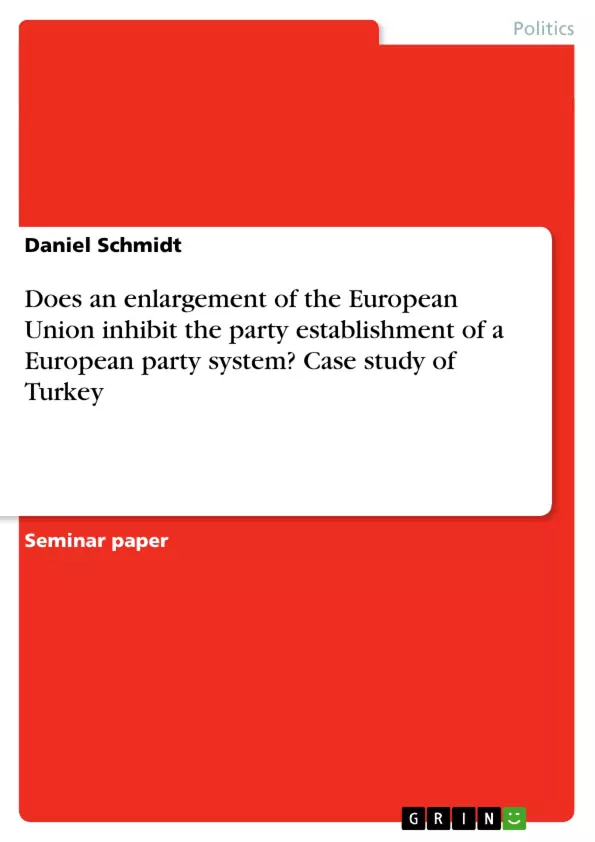1. Introduction
The European Union (EU) has been a very heterogeneous building since the start. The difficult task is forming a party system which fits the different national parties in coalitions that are able to produce results. With the now 25 members this seems even more problematic, since the states of Eastern Europe have a tradition that differs significantly from the countries in Northern and Western Europe.
It is, therefore, necessary to prove if party cohesion on the European level exists. If members of European Parliament (EP) would only vote on national interest, party coalitions would not serve their purpose. There needs to be cohesion towards the coalition in order to establish real European elections instead of second order national elections. In order to achieve this it is also necessary to be able to have a public opinion that can be organized into majorities (Beetham/Lord, 2001:77).
The questions, therefore, remain if the EU is able to establish even more members in its middle. It might be the case that new members would decline the party cohesion even further and that would make It even more difficult to establish true European elections.
In this paper, special emphasis will be on the role of Turkey and the adoptability into the party system. The leading hypotheses will be that the cleavages lines which are important for Turkish voters are too different in order to adopt to leading European ideas. A sup-question is also if the Eastern European countries have yet performed this step.
The paper will start with a normative frame that points out how an ideal democracy could work on the European level. Because of shortage of space this can not be discussed in total depth, but the presented ideas will serve as a framework.
After the theoretical part, the focus will be on the European system as it works today. Special emphasis will be on the party coalitions and their impact on the voting behaviour of members of parliament (MEP). It is essential to describe why national parties have agreed to work together and what political solutions they prefer. Since there are seven coalitions in the EP today, not all can be fully analysed. Therefore, the two biggest groups (EVP-ED and SPE) will mainly be the focus, since they hold over 60% of the seats.
The next part will analyse the Turkish system and what kind of issues are deciding for Turkish voters. The history of democracy will be the starting point of this analysis before the present situation will be the focus.
The conclusion will, therefore, be based on the question if Turkey’s party system can adapt to the EU, and, thus, the entry of Turkey into the EU is feasible taking these conditions into account.
Inhaltsverzeichnis (Table of Contents)
- Introduction
- Theoretical part of a European party system
- Intergovernmental Approach
- Supranational Approach
- Fractions in European Parliament
- Party of European socialists (PES)
- European People Party (EPP)
- Cohesion of the fractions in European parliament
- Turkey and its party system
- Democracy in Turkey
- Establishing of democracy
- Recent politics in Turkey
- The 2003 elections
- Reasons for the elections in Turkey
- Conclusion
Zielsetzung und Themenschwerpunkte (Objectives and Key Themes)
This paper explores the potential impact of the European Union's (EU) enlargement on the development of a cohesive European party system, particularly focusing on the case of Turkey. The central objective is to determine if Turkey's party system can adapt to the EU's framework and whether its entry into the EU is feasible considering existing political structures and dynamics.
- The challenges of forming a cohesive European party system across diverse national parties and political traditions
- The role of intergovernmental and supranational approaches in shaping European democracy
- The influence of national interests and voting behavior on the effectiveness of European party coalitions
- The unique characteristics of Turkey's party system and its potential compatibility with the EU's framework
- The impact of Eastern European countries on the development of a European party system
Zusammenfassung der Kapitel (Chapter Summaries)
- Introduction: This chapter introduces the challenges of establishing a cohesive European party system within the EU, particularly considering the diversity of national parties and the expansion of the bloc to include Eastern European countries. It highlights the importance of party cohesion for effective European elections and the role of public opinion in shaping political outcomes.
- Theoretical part of a European party system: This chapter examines two contrasting approaches to European democracy: intergovernmental and supranational. It discusses the strengths and weaknesses of each approach and argues that a purely intergovernmental system might not adequately address the evolving complexities of EU governance.
- Fractions in European Parliament: This chapter focuses on the functioning of the European Parliament, specifically highlighting the two largest party groups, the European People's Party (EPP) and the Party of European Socialists (PES). It examines the factors that contribute to the cohesion of these groups and their impact on voting behavior.
- Turkey and its party system: This chapter delves into the specific case of Turkey, analyzing its political history, the development of its democracy, and the key factors influencing Turkish voters. It examines the political landscape in recent years, including the 2003 elections, and explores potential challenges related to Turkey's integration into the EU party system.
Schlüsselwörter (Keywords)
The key themes explored in this paper include European party system, intergovernmentalism, supranationalism, party cohesion, national interests, European elections, Eastern European countries, Turkey, democracy, party system, EU enlargement, and political integration.
- Citar trabajo
- Daniel Schmidt (Autor), 2007, Does an enlargement of the European Union inhibit the party establishment of a European party system? Case study of Turkey , Múnich, GRIN Verlag, https://www.grin.com/document/91677



